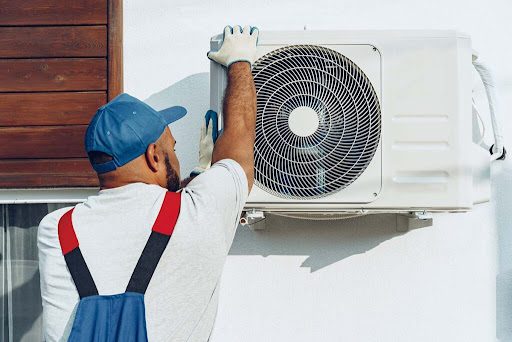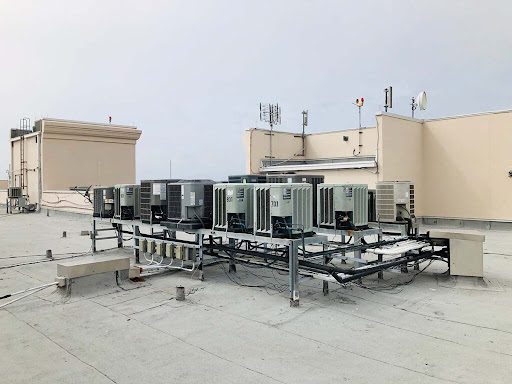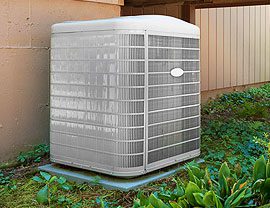While most people associate air conditioning with a cold room, the science behind making your home cooler deals with the transfer of heat. When the heat is lost or removed, the remaining cold air cools your home.
A basic law of physics called the conservation of energy states that you cannot destroy energy. If you are wanting to remove heat from a room on a hot day, you cannot get rid of it completely.
You can however convert it to another form or move it to another area.
To understand this system better, let’s look at the major components.
Your AC has two key components: the indoor unit, and the outdoor unit. These two units work together to keep your home comfortable all year round.
Functions of an Air Conditioning Indoor Unit
The indoor unit consists of a coil box that contains an evaporator. This evaporator holds a cooling fluid inside the coiled piping called refrigerant. Refrigerant is a volatile liquid that undergoes phase transitions from liquid to gas, and then back again based on the pressure applied to it.
Once the heat inside of your home is absorbed, it leaves nothing but cool air to recirculate inside. If you consider how water absorbs heat from your stove to boil and evaporate, similarly the refrigerant absorbs heat from the air.
According to Build, an AC indoor unit is best placed wherever it is needed most, generally over where you sit or sleep and up high, as cool air invariably sinks to the bottom of a room while heat rises.
Functions of an Air Conditioning Outdoor Unit


The outdoor unit contains a compressor, condenser coil and a fan. The heat absorbed from the air within your home is transferred through the indoor unit to the outdoor unit, passing through a compressor. The compressors primary job is to move the refrigerant throughout the system.
All the extra heat created by compressing the gas is then evacuated outdoors with the help of the second set of coils called condenser coils, and a second fan. As the refrigerant cools, it changes back to a liquid and the process starts all over again.
The AC outdoor unit will generally be installed against the outside wall of the room being air-conditioned and should be mounted in a stable place where they won’t vibrate and where the noise will not affect others.
How Your AC Units Work Together
Warm air from the room is sucked in through a grill at the base of the machine. The air flows over cooled pipes in which coolant fluid is circulating. This part of the unit works similarly to the freezer of your refrigerator. The incoming airflow reduces in temperature as they pass through these pipes while a dehumidifier removes excess moisture.
With the AC unit temperature turned up, the air would then flow over a heating element. This works similar to how a fan heater distributes warm air.
A fan at the top then moves air back through another grill and into the room. If the heating element is turned down the air is recirculated as cooler air, cooling down the room.
While all of this is happening, the refrigerant flows through the cooling pipes picking up heat from any air blowing past, turning from a cool liquid into a hot gas. This allows the unit to carry heat from inside the room to outside the building.
The unit outside the building dissipates the heat, using multiple metal plates. A fan then pushes air through them to accelerate the process.
Once the heat has been released from the building the refrigerant reduces in temperature ready for the next cycle.
Common Myths About How Your AC Works
Although the first modern air conditioning system was invented in 1902, by Willis Carrier. Many people still have trouble separating certain air conditioning facts from fiction. Over time, some of these misconceptions have become accepted as common knowledge.
Let’s explore some common misconceptions about how your air conditioning unit works.
The AC filter is there to clean indoor air.
Quite often people assume an air conditioner also cleans the air in their home. The unit does hold a filter inside, however, the filter is there to protect the interior of the air conditioning unit.
Not to clean the air of your home.


If there are no visible problems, your AC doesn’t need regular maintenance.
Even if your air conditioner seems to be running as new, it is advised to have it serviced annually by a technician. Regular maintenance protects energy efficiency, which can save you on your power bill, and extends the operational lifespan of your unit. It also pays to check the warranty, as regular maintenance may be a requirement to keep your warranty valid.
A lower number on the thermostat does not mean cooler air, faster.
Even if you set your thermostat at the lowest possible setting, your AC unit will continue to run at the same pace. Setting the thermostat closer to the outside temperature will save you money. According to Golden Rule PHC, it is recommended to never lower the thermostat below 70°F. Setting the thermostat too low can also damage the AC’s indoor coils over time.
An AC needs its refrigerant to be occasionally refilled.
Your air conditioning unit is not an open unit, therefore there is no need to refill your refrigerant supply. Refrigerant is a harmful substance that can also damage the ozone layer. If you suspect a refrigerant leak this is best dealt with by an air conditioning technician. When there is a leak your unit becomes less efficient meaning your AC unit works harder to treat the same amount of air.
It’s normal to see ice on an air conditioner.
The coils within your air conditioning unit may work similarly to your refrigerator however, even too much ice building up in your freezer is a sign something is wrong. When it comes to air conditioning, ice should never appear on an AC unit. If you do see ice along with the evaporator coil, it is best to have your unit checked out by a trained technician as soon as possible.
Summary
Air conditioners come in a range of shapes and sizes, nevertheless, they all operate on the same basic principle. An air conditioner provides cool air inside your home by extracting the heat, returning cooler air into your space. The warm air is transferred outside, and the cooler air inside is recirculated.
Put simply the functionality of air conditioning units, is less about increasing cold, and more about removing existing heat.
Regardless of which type of system works for your home, knowing the basics of how air conditioners work will help you choose a unit that makes the most sense, allowing you to better understand what your air conditioning expert is presenting to you.


References
- Explain That Stuff. The conservation of energy. https://www.explainthatstuff.com/conservation-of-energy.html
- FJC. Coolant? Refrigerant? Whats the Difference?. https://fjcinc.com/coolant-refrigerant-whats-the-difference/
- Build. Where to position air conditioners and fans. https://build.com.au/where-position-airconditioners-and-fans
- Golden Rule PHC. 5 Big Misconceptions About Air Conditioning. https://goldenrulephc.com/blog/5-big-misconceptions-about-air-conditioning
- Carrier. Air Conditioners, HVAC Education. https://www.carrier.com/residential/en/us/products/air-conditioners/how-do-air-conditioners-work/



